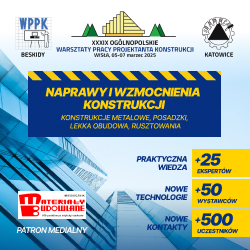Open Access (Artykuł w pliku PDF)
Comparative characteristics of polymer fiber reinforced concrete strength
mgr inż. Julia Blazy, Politechnika Śląska; Wydział Budownictwa
ORCID: 0000-0001-9525-8650
prof. dr hab. Łukasz Drobiec, Politechnika Śląska; Wydział Budownictwa
ORCID: 0000-0001-9825-6343
Adres do korespondencji: Ten adres pocztowy jest chroniony przed spamowaniem. Aby go zobaczyć, konieczne jest włączenie w przeglądarce obsługi JavaScript.
DOI: 10.15199/33.2022.09.02
Oryginalny artykuł naukowy
Streszczenie. Celem artykułu była analiza porównawcza wytrzymałości betonu z dodatkiem włókien polimerowych uzyskanych w badaniach jednoosiowego rozciągania, trzypunktowego zginania i rozłupywania Montevideo. Wykonano jedną mieszankę bez włókien i pięć mieszanek fibrobetonowych z 2 lub 3 kg/m3 włókien o różnej geometrii i formie. Stwierdzono, że dodanie włókien nie wpłynęło w istotny sposób na maksymalną wytrzymałość betonu na ściskanie, jednoosiowe rozciąganie, zginanie i rozłupywanie. Natomiast poprawie uległy siły i wytrzymałości resztkowe, energia pękania i ciągliwość betonu. Obliczony współczynnik korelacji obciążenia (kTRMV = 1,5) pozwolił na porównanie wyników testu rozłupywania Montevideo z testami trzypunktowego zginania przy szerokości rozwarcia rysy większej niż 1 mm. Test rozłupywania Montevideo może być prostszą i bardziej kompaktową metodą badawczą w porównaniu z testem trzypunktowego zginania.
Słowa kluczowe: fibrobeton; włókna polimerowe; test jednoosiowego rozciągania; test trzypunktowego zginania; test rozłupywania Montevideo.
Abstract. The aim of the article was a comparative analysis of concrete strenght with the addition of polymer fibers subjected to three testmethods: the uniaxial tensile test, the three-point bending test, and the Montevideo splitting tensile test. One mix without fibers and five fiber reinforced concrete mixes were made with 2 or 3 kg/m3 of polymer fibers of different geometry and form. It was found that the addition of fibers did not significantly affect the maximum compressive, uniaxial tensile, flexural, and splitting tensile strength of concrete. On the other hand, residual forces and strengths, fracture energy, and ductility of concrete were significantly improved. The calculated load correlation coefficient (kTRMV = 1.5) allowed the correlation of the results of the Montevideo splitting tensile test with the three-point bending test for a crackmouth opening displacement greater than 1mm.Overall, the Montevideo splitting test may be a simpler and more compact test method compared to the three-point bending test.
Keywords: fiber reinforced concrete; polymer fibers; uniaxial tensile test; three-point bending test;Montevideo splitting tensile test.
Literatura
[1] ChorzepaMG,MasudM. Performance of multiscale, including nanoscale, fibres in concrete.EmergingMaterials Research. 2017; doi: 10.1680/jemmr. 16.00020.
[2] Blazy J,DrobiecŁ,WolkaP.Flexural tensile strength of concrete with synthetic fibers. Materials. 2021; doi: 10.3390/ma14164428.
[3] Maj M, Ubysz A. Cracking of composite fiber reinforced concrete foundation slabs due to shrinkage.Materials Today: Proceedings. 2021; doi: 10.1016/j.matpr.2020.10.155.
[4] Altoubat SA,Roesler JR,LangeDA,RiederK. Simplified method for concrete pavement design with discrete structural fibers. Construction and BuildingMaterials. 2008; doi: 10.1016/j.conbuildmat. 2006.08.008.
[5] International Federation for Structural Concrete, „Model Code 2010, Final draft-Volume 1”. 2013.
[6] Louch K, Day R, Hulett T, Woods N, Eddy D, Simpson D. Technical Report 34. Concrete industrial ground floors. A guide to design and construction, 4. wyd., t. 29, nr 1.Camberley:TheConcreteSociety, 2016.
[7] Linsbauer HN, Tschegg EK. Fracture energy determination of concrete with cube shaped specimens”, Zementund Beton. 1986; t. 31: 38 – 40.
[8] Segura-CastilloMonte LR, de FigueiredoAD. Characterisation of the tensile constitutive behaviour of fibre-reinforced concrete: A new configuration for the Wedge Splitting Test. Construction and Building Materials. 2018; doi: 10.1016/j.conbuildmat.2018.10.101.
[9] EN 12350-2:2019-07. Testing fresh concrete – Part 2: Slump test. 2019.
[10] EN 12350-8:2012. Testing fresh concrete – Part 8: Self-compacting concrete – slump-flow test. 2012.
[11] EN 14651+A1:2007 Testmethod formetallic fibre concrete –Measuring the flexural tensile strength (limit of proportionality (LOP), residual). 2007.
[12] Blazy J, Drobiec Ł. Wpływ włókien polipropylenowych na ściskanie i rozciąganie betonu w świetle PN-EN 206-1 i PN-EN 14651. Inżynieria i Budownictwo. 2021.
[13] Blazy J, Drobiec Ł. Analiza wyników badań fibrobetonu z włóknami polimerowymi. Inżynieria i Budownictwo. 2021; t. 9 – 10:. 477 – 481.
[14] Park G, Park G, Park J, Lee N, Kim S. Residual Tensile Properties and Explosive Spalling of High-Performance Fiber Reinforced Cementitious Composites Exposed to Thermal Damage. Materials. 2021; doi: doi.org/10.3390/ma14071608.
[15] PimentelM, Nunes S. On the Double-EdgeWedge-Splitting Test for the Characterisation of HPFRC in uniaxial Tension. HiPerMat 2016: Ultra-High Performance Concrete and High Performance Construction Materials, nr 1, ss. 1–8, 2016.
Przyjęto do druku: 08.09.2022 r.
Materiały Budowlane 09/2022, strona 44-48 (spis treści >>)





























